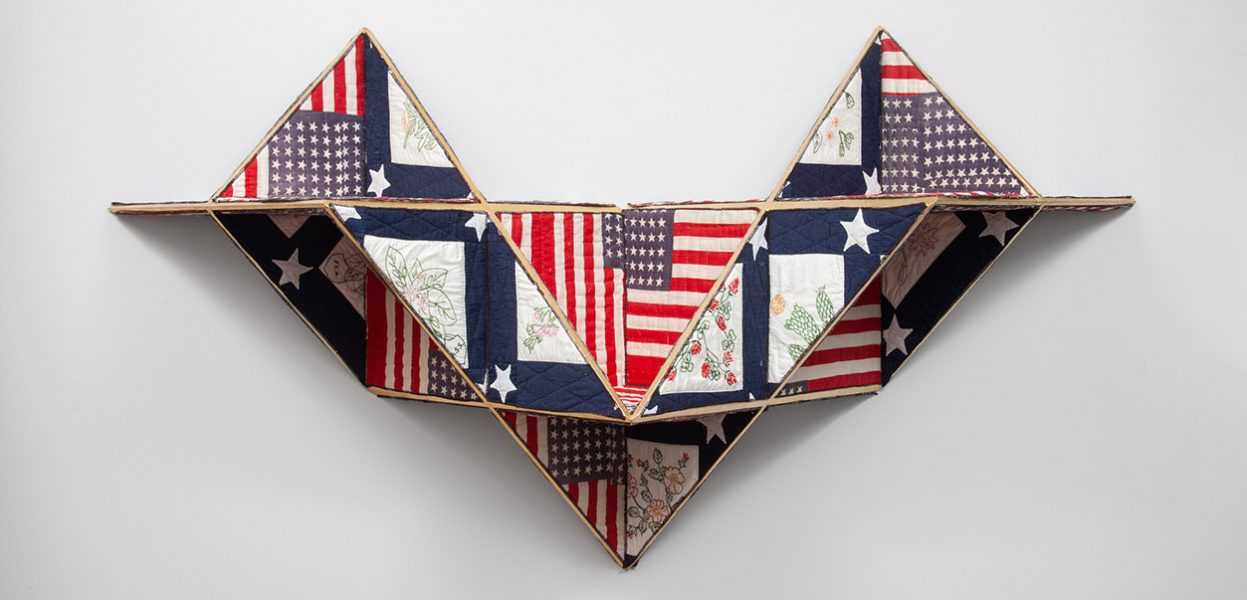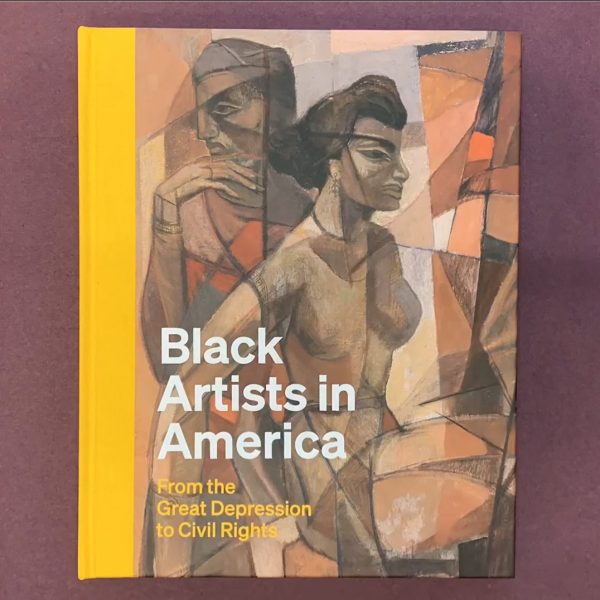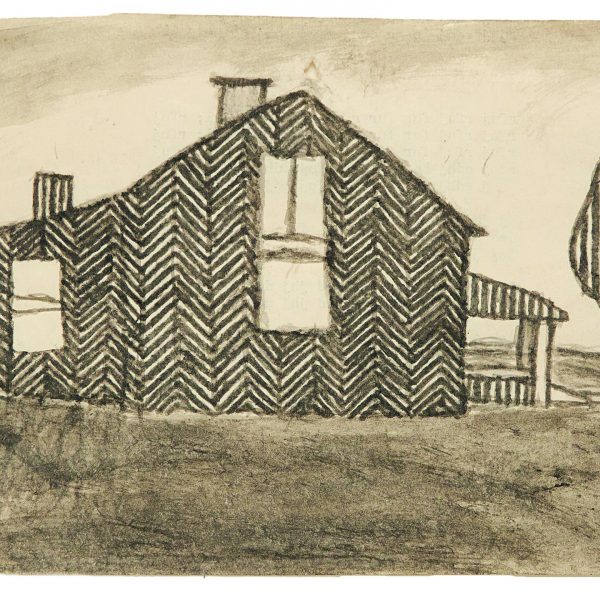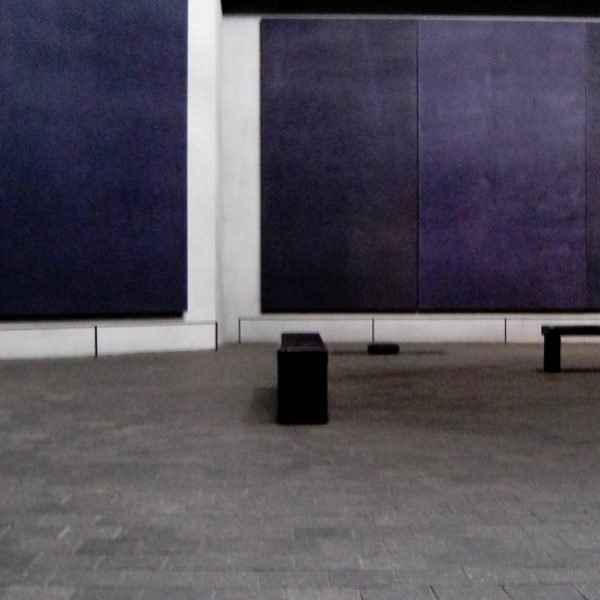Changeability for Survival: Sanford Biggers’s Codeswitch
Interview with the artist by David Ebony
Sanford Biggers is a multifaceted, multi-talented artist with a singular, global vision. A major touring museum solo of works by the Los Angeles-born (1970), New York-based artist, Codeswitch features some sixty large-scale “quilt paintings,” as well as a number of relief constructions, and videos. Scheduled to open at the Bronx Museum of the Arts last April, but postponed due to the Covid-19 epidemic, it debuted at the museum last September, and runs through April 5, 2021.

Co-organized by Bronx Museum curator Antonio Sergio Bessa, and Andrea Andersson, director of Rivers Institute for Contemporary Art & Thought, New Orleans, the show is set to appear at the California African American Museum in Los Angeles, July, 2021 through February, 2022. The Bronx Museum of the Arts appearance also coincided with Soft Truths, a show of recent works at Marianne Boesky Gallery in New York, October 30-December 12, 2020.
In his works, Biggers addresses issues of race, African-American struggle and oppression. They also allude to art-historical precedents, and elevate properties of craft and craftsmanship to new levels of expressivity. His use of found materials—in the quilt paintings, and in the geometric, fabric-covered wood-panel constructions—corresponds in fascinating ways to works by artistic forebears like Robert Rauschenberg, Annie Albers, Terry Atkins, David Hammons, Faith Ringgold, Betye Saar, and Sam Gilliam. Biggers’s hyper-estheticized objects and installations also offer viewers an immersive and mediative experience.
Having lived for several years in Japan, and with an interest in Buddhism, Biggers produces works that often suggest a spiritual dimension in their formally elegant, physical comportment. Performance is also central to Biggers’s oeuvre, and his collaborative music group Moon Medicin directly connects with live audiences.

Codeswitch is accompanied by a lively book of the same name, with essays by Andersson and Sergio Bessa, and a chronology of slavery in the United States, with notes on Quilting and Afrofuturism. Also featured in the book is Motherpatchwork, a twenty-page section in the form of a colorful, graphic novel, centered on the theme of quilting, by artists John Jennings, David Brame, and Esperanza Bey.
In a recent phone conversation, I spoke with Biggers about Codeswitch—the exhibition and book—and its long-term implications. We also discussed his career goals, artistic passion, and music, including his band, Moon Medicin, and thoughts about the future.
Ebony How are you? How are you dealing with the pandemic?
Biggers Lots of ups and downs—lots of tragedy, obviously, in the country and the world. I’ve had family members and friends pass away recently, not necessarily from Covid, but it’s been a tumultuous time to say the least. My family and I have been out of New York City for a while, so we’re feeling a bit displaced, between homes at the moment. It’s been crazy, but I know it’s been difficult for everybody.
Ebony At this extraordinary time you have an extraordinary museum exhibition on view. I just wanted to ask you about the show’s title Codeswitch. Can you say a few words about it, and what it means?
Biggers Codeswitching explains how different modes of communication and linguistic tropes can be used to speak to different groups of people. You might address one group a certain way and then change to accommodate another audience. There’s a social aspect to it as well, for instance, disenfranchised people often have to adopt different code-switching techniques to adapt to different scenarios. There might be a different attitude, behavior, diction or way of dressing that you use at work, and could be very different from the way you address your family at home, or friends in the neighborhood, or a love interest, and so on. I often think it’s a survival tactic for many people.
As it relates to the show, the body of work that comprises Codeswitch is from a series of paintings and drawings that I’ve been doing on antique quilts that I call the Codex series. I call it the Codex series for a few reasons; one of them is that I look at this series as almost an expanded sketchbook, and a place where you can go and decipher other art objects and projects that I’ve done. For example, you can look at a quilt and it will give you clues to some of my installations like Blossom, the piano with the tree coming out of it, or the “Bans” series of bronze pieces that were made from shooting African sculptures. Elements of those projects are visible in the quilts, so it’s a codex, but also codeswitching because these works are between paintings, drawings, soft sculptures, performative objects. We know they’ve been used, they’ve been worn, they’ve draped bodies—so they’re in a mysterious interim place, between various practices.

Ebony For me, an exciting moment in the exhibition was when I saw your Quilt #35 (Vex), 2014, and discovered the QR code in yellow that you embedded in the painting. When I put my phone up to it, it led to your band Moon Medicin’s website. It was quite a surprise, and I started looking through the show again in search of more QR codes. Are there more?
Biggers Yes. There are some other QR codes hidden in other works. It’s interesting that QR codes had a big moment, almost a decade ago, and then nobody used them. And that’s when I got interested in them. I did a couple of QR pieces. But the technology hadn’t really caught up enough to be convenient. Now, though, most phones and cameras come with a QR reader. And now that we’re all remote lately, it’s back in vogue; so it’s a great time to start using them again. I have a few upcoming projects that will be using QRs to link to virtual elements of the piece.
Ebony This leads me to ask you about Moon Medicin and your relationship to music. How is music part of your work as a whole; and can you say a few words about the band?
Biggers Before I started to consider myself a visual artist, I was learning piano—this was when I was in my early teens, pre-teens, actually, when I started to take piano lessons. I took lessons for a while—hated them—stopped, and began to play by ear. My older brother had been in bands, so I was always hanging out with him and the other musicians in the bands, and learning things. Then I started getting into garage and high-school bands when I was a kid. I got to the point when I started listening to jazz—when I was maybe thirteen or fourteen years old. I couldn’t play what I heard. So I had to just pull back, and I started paint and draw portraits of the people, the musicians I was listening to—Thelonious Monk, Sun Ra, and so on. That got me going down the visual path initially.
In addition to that, I was also doing graffiti—New York-style graffiti, which, as you know, was in tandem with the development of hip-hop and rap music. I was there from the beginning—from 1979 on, so there was another link to visual art and music. I decided to go totally into art because for me it was a way to communicate ideas, and so I began to explore visual concepts. Moon Medicin is collaborative performance ensemble that I initiated in 2007. Our first show was part of Performa, the performance art festival. It was at The Box, a notorious underground club. The group of poets, musicians, and performers I work with on Moon Medicin has by now become what I refer to as an “interstellar boy band,” which is really facetious since there are often women in the band, and gender is not really part of the equation. Moon Medicin is definitely in the performance-art realm.

Ebony You started using quilts in your work in 2009. What attracted you to them?
Biggers There were some things that built up to the use of quilts. It was nothing I really set out to do. But when I was growing up there were quilts around my home. My parents are from Texas, so when I would go to Texas, I would see lots of quilts. One of the first things that happened was I went to the Whitney Museum to see show of incredible quilts by the women of Gee’s Bend. I was interested in them as autonomous objects. But I was also interested in their context in the Whitney, which usually promulgated abstract works by white male artists. The quilts more than held their own against—and were a lot more inspiring to me—than nearly anything else in the museum, or most other works I was seeing at the time. The dichotomy of a Whitney exhibition of works by a group of Black women was really fascinating.
Later on, while I was doing a project in Philadelphia, I started to learn about the contested history of whether or not quilts were used along the Underground Railroad as signposts. The legend goes that quilts of a certain pattern or folded a certain way were put outside the homes, and as escaping slaves moved north, they would read the quilts, and know if they could stay at a certain safehouse, or how far up the road they should go before making a turn. So there was coded messaging within the quilts. It was a jumping off point for me, to think of myself as a late collaborator with the groups of people, or individuals who made the original quilts. And then I would add another layer of code directly onto the quilts. It relates to your question about the QR code, which is just another type of code to embed in the quilts.

Ebony Did you ever make a quilt yourself?
Biggers I have never made an entire quilt myself. I’m at best a provisional sewer; I’ve done work to repair some quilts, and I’ve sewn additions to quilts. I’ve never constructed one from scratch.
Ebony So the ones in the show you acquired online or in flea markets and such?
Biggers Some from flea markets, and some from online, but also a lot have been donated. Many people have quilts or collected quilts, and then at a certain point they don’t know what to do with them. There’s an instant nostalgia about quilts, and a feeling of responsibility. No one wants to just throw out a quilt. They find people to donate or gift them to. I’ve come into my studio and found boxes of quilts or fragments of quilts that someone dropped off—sometimes they drove an hour or two to get to my studio. They are often quilts that were inherited from a passed grandmother, or an aunt, and they hope to find a way for those pieces to be resuscitated.
Ebony In Andrea Andersson’s terrific essay in the book, she refers to you as an allegorist working in the long tradition of history painting. Could you comment on that?
Biggers I’ve always looked at my projects—whether it be the quilts, the sculptures, the installations or video, and even Moon Medicin—to be focused on history, considering history itself to be a medium. Through those things, you can read visual history, as in the quilts, where the quilt’s history combines with painting’s art history. If I’m conflating history, I place scenes from comic books for instance, next to images from the Tibetan Book of the Dead, next to drawings or sketches by da Vinci and Buckminster Fuller—that represents thousands, or at least hundreds, of years of visual history. In the case of the quilts, they may have been made a hundred years ago, and here they are being shown in a contemporary art context, where they can spark a dialogue about social justice, and other issues.
Ebony The quilts in the show are so visually sumptuous, and filled with optical illusions. You often use drop shadows, and there are a lot of other abstract visual puns. At first, they seem gestural; then you realize that there are rigorous design elements in each composition. Are they carefully composed in the studio? Do you do studies before you start painting on the quilts? And are the wall reliefs put together with the help of computers? Is there a specific design program that you use?
Biggers With the quilts, it’s really a combination. I’m always trying to find new ways to react to the already existing images in the quilts. So, shadows, and trompe-l’oeil all come into play. Sometimes they’re totally improvisational. I spend a lot of time with the quilts, but I don’t have a preconceived idea of the result, or anticipate how the quilts will look before I start working on them. For the wall reliefs, there is no computer involved; they are totally improvised. They are literally patchworks put on armatures, and put together—and then the magic happens.

Ebony Now that you—and art audiences—have lately had an in-depth examination of your work to date, with the museum survey, plus recent gallery exhibitions, how does that influence what comes next? What do you think is your next direction, changes in your process, or what do you think your future work will be?
Biggers I’ve always looked at my work as a comprehensive whole. The Codex, and Codeswitch series, Soft Truths, the bronze sculptures, the installations, and so on, although visually seem very different, conceptually, they are from the same nucleus for me. For the future, I would just like to move forward on a similar path, so that collectively these diverse works would add to a cohesive way of thinking, a way of expressing, and a way of traversing subject matter, time, and materials, infused with a lot of visual and experiential elements.
Sanford Biggers is an interdisciplinary artist who works in film/video, installation, sculpture, music, and performance.
David Ebony is a contributing editor of Art in America, as well as a contributor to several other publications, and the author of numerous artist monographs.


























